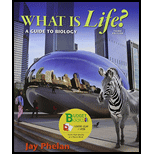
Loose-leaf Version for What is Life? A Guide to Biology
3rd Edition
ISBN: 9781464172274
Author: Jay Phelan
Publisher: W.H. Freeman & Co
expand_more
expand_more
format_list_bulleted
Concept explainers
Question
Chapter 2, Problem 3MC
Summary Introduction
Introduction:
Covalent bonds are formed by the sharing of electrons.
Expert Solution & Answer
Want to see the full answer?
Check out a sample textbook solution
Students have asked these similar questions
This type of noncovalent bond is responsible for clustering fatty acid tails of phospholipids in a micelle.
a. Disulfide bonds
b. Hydrogen bonds
c. Hydrophobic interactions
d. Ionic interactions
e. van der Waals interactions
Rank the following chemical bonds in order of increasing polarity.a. nonpolar covalent b. ionic c. polar covalent
. A cation is a(n)a. uncharged atom.b. positively charged atom.c. negatively charged atom.d. atom that has gained an electron
Chapter 2 Solutions
Loose-leaf Version for What is Life? A Guide to Biology
Ch. 2 - Prob. 1SACh. 2 - Prob. 2SACh. 2 - Prob. 3SACh. 2 - Prob. 4SACh. 2 - Prob. 5SACh. 2 - Prob. 6SACh. 2 - Prob. 7SACh. 2 - Prob. 8SACh. 2 - Prob. 9SACh. 2 - Prob. 10SA
Ch. 2 - Prob. 11SACh. 2 - Prob. 12SACh. 2 - Prob. 13SACh. 2 - Prob. 14SACh. 2 - Prob. 15SACh. 2 - Prob. 16SACh. 2 - Prob. 17SACh. 2 - Prob. 18SACh. 2 - Prob. 19SACh. 2 - Prob. 20SACh. 2 - Prob. 1MCCh. 2 - Prob. 2MCCh. 2 - Prob. 3MCCh. 2 - Prob. 4MCCh. 2 - Prob. 5MCCh. 2 - Prob. 6MCCh. 2 - Prob. 7MCCh. 2 - Prob. 8MCCh. 2 - Prob. 9MCCh. 2 - Prob. 10MCCh. 2 - Prob. 11MCCh. 2 - Prob. 12MCCh. 2 - Prob. 13MCCh. 2 - Prob. 14MCCh. 2 - Prob. 15MCCh. 2 - Prob. 16MCCh. 2 - Prob. 17MCCh. 2 - Prob. 18MCCh. 2 - Prob. 19MC
Knowledge Booster
Learn more about
Need a deep-dive on the concept behind this application? Look no further. Learn more about this topic, biology and related others by exploring similar questions and additional content below.Similar questions
- Define the following terms: a. dipole b. hydrogen bond c. electrostatic interaction d. covalent bond e. hydrationarrow_forwardA solution that conducts electricity must contain Select one: a. Hydrophobic molecules b. Polar molecules c. Ionsarrow_forwardWhich of the following describes the interaction between the amino acid last eluted and the anion exchanger at pH 7? a. dipole-dipole b. hydrophobic c. ionic d. H-bondingarrow_forward
- Which of the following bonding types is the most important in the nonaqueous interfaces between protein subunits? a. van der Waals interactions b. the hydrophobic effect c. ionic bonds d. disulfide bridgesarrow_forward.Amino acids a. have high dipole moments. b. are weak acids. c. with high molecular masses will be insoluble in water. d. are weak bases. Which statement is false?arrow_forwardThe mutual attraction of opposite charges holds atoms together as molecules in an _______ bond. a. ionic c. polar covalent b. hydrogen d. nonpolar covalentarrow_forward
- One of the results of a fat being saturated is that the molecules interact stronger. This means that saturated fats are usually solid at room temperature while unsaturated fats are typically liquids. The interactions between triglycerides falls under which of the following types. Select one: a. Covalent Bonds b. van der Walls bonds c. Hydrogen Bonds d. Ionic Bondsarrow_forwardDefine the following terms: a. phospholipids b. soap c. surface active agent d. phosphoglyceride e. sphingomyelinarrow_forwardA (-) charge in the transition state can be stabilized by a catalyst, which is usually a(n): a. Anion b. Base Oc. Nucleophile Od. Acidarrow_forward
- The “octet rule” in chemistry helps predict the types of bonds thatatoms will form. In general, an atom will be most stable if it fills itsouter shell of 8 electrons. Atoms with fewer than 4 valence electronstend to donate electrons and those with more than 4 valence electronstend to accept additional electrons; those with exactly 4 can do both.Using this rule, determine what category each of the followingelements falls into: N, S, C, P, O, H, Ca, Fe, and Mg. (You will needto work out the valence of the atoms.)arrow_forward.Which of the following substances would be considered basic? A. hydrochloric acid (pH 1.0) B. milk (pH 6.6) C. baking soda (pH 8.1) D. water (pH 7.0) E. Dr. Pepper (pH 3.0)arrow_forwardThe type of bonding that happens between atoms within a water molecule is which of the following? a. Polar covalent bonding b.ionic bonding c. Non polar covalent bonding d. Hydrogen bondingarrow_forward
arrow_back_ios
SEE MORE QUESTIONS
arrow_forward_ios
Recommended textbooks for you

Macromolecules | Classes and Functions; Author: 2 Minute Classroom;https://www.youtube.com/watch?v=V5hhrDFo8Vk;License: Standard youtube license